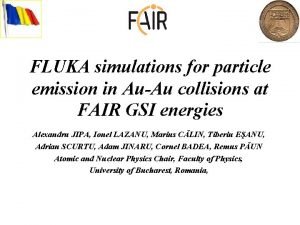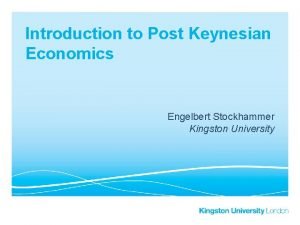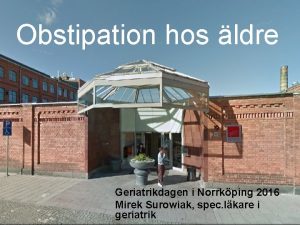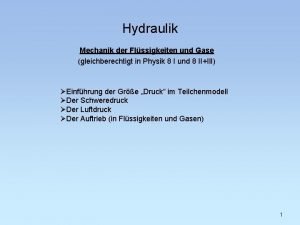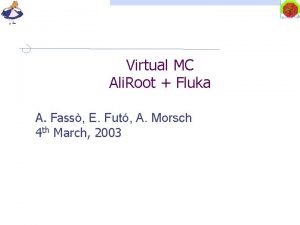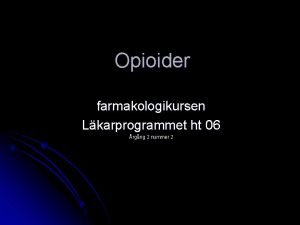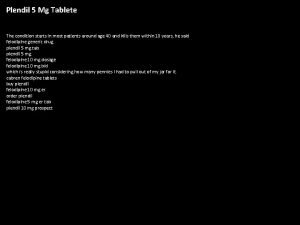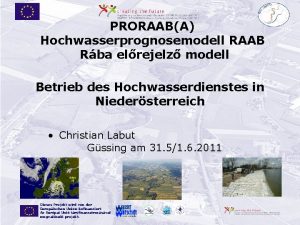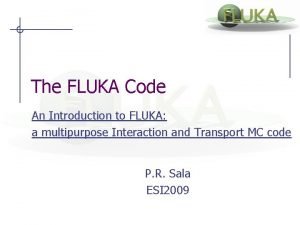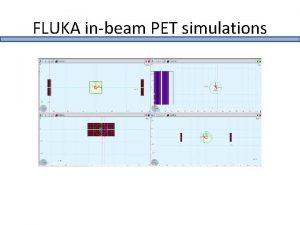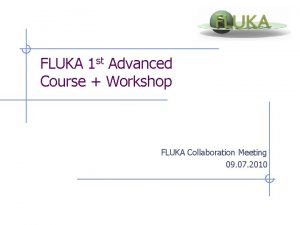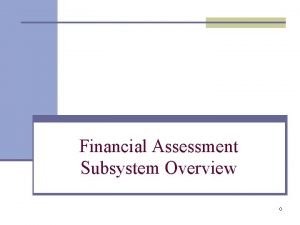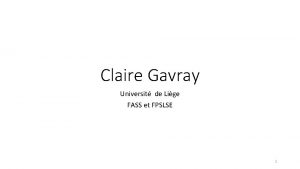Status of FLUKA A Fass 4 th March
















- Slides: 16

Status of FLUKA A. Fassò 4 th March, 2003 1

FLUKA A. Fassò, A. Ferrari, P. R. Sala, J. Ranft 1962: J. Ranft (Leipzig) and H. Geibel (CERN): the first Monte Carlo for high energy beams The name: 1970 (event by event fluctuations in calorimeters: FLUktuierende KAskade) Early '70 s-1987: Leipzig-Helsinki-CERN collaboration (shielding of the SPS) Since 1990: the present code, mostly INFN (Milan). Little or no remnant of the old versions GFLUKA: 1993. No development/update since 2001: Fluka is an official INFN project March 2003 ALICE Offline Week 1

February 2003: collaboration agreement CERN-INFN EP and AB Divisions, INFN and the authors agree to collaborate in order to prepare a full release of the FLUKA code, including the source code and the documentation, within 12 to 18 months Resources made available for the project: 1 FTE (12 -18 mo) from EP 1 FTE from AB Coordinating Committee with representatives from AB, EP, INFN, authors First step towards a long term collaboration March 2003 ALICE Offline Week 1

Guidelines for the Committee Main purpose of the agreement: “to make FLUKA fully available to the scientific community, while protecting the scientific rights of the authors and the integrity of the code” Will be recognized as FLUKA “only what is obtained by the authors” The scientific management (model development, release policies, etc. ) “remains in the hands of the authors” Important contributors can be added to the author's list The code or parts of it can be inserted into other codes or translated to other languages only with agreement of the authors The same for “significant modifications” of the code March 2003 ALICE Offline Week 1

The FLUKA hadronic models Hadron-nucleon: elastic, exchange: phase shifts, data, eikonal p<3. 5 Ge. V/c: resonance production and decay low-energy � , K: special high-energy: Dual Parton Model, hadronization Hadron-nucleus: p<4. 5 Ge. V/c: PEANUT (GINC+preequilibrium) high-energy: Glauber-Gribov final nucleus de-excitation: evaporation, fission, Fermi break-up, �de-excitation March 2003 ALICE Offline Week 1

Limitations in the old versions (including GFLUKA) now eliminated Glauber cascade at an elementary level All resonances assumed on mass shell Coarse chain hadronization, no attention to threshold and finite mass effects Isospin conservation not enforced at each individual hadron production step Transverse motion not satisfactory Simplified description of diffractive processes March 2003 ALICE Offline Week 1

Neutron transport below 20 Me. V ENEA multigroup cross sections: 72 groups, about 100 elements/isotopes Different temperatures, Doppler broadening, selfshielding Standard multigroup transport with �and fission neutron generation Detailed kinematics and recoil transport for elastic/inelastic scattering on H and 14 N(n, p), 10 B(n, � ) and 6 Li(n, x) reactions Correlated capture � for Cd, Xe Kerma factors to calculate energy deposition Residual nuclei production March 2003 ALICE Offline Week 1

EMF: Electro. Magnetic Fluka Photoelectric: fluorescence, angular distribution, Auger, polarization Compton, Rayleigh: atomic bonds, polarization Pair production: correlated energy/angular distribution (also for � ) Bremsstrahlung: LPM, angular distribution, finite at tip (also for �) Bhabha and Møller scattering Positron annihilation at rest and in flight � capture at rest (Goulard-Primakoff formula) Optical photons (Cerenkov) production/transport March 2003 ALICE Offline Week 1

Photonuclear reactions Giant Resonance Quasi-deuteron effect Delta Resonance Vector Meson Dominance INC, preequilibrium, evaporation via PEANUT Also for � March 2003 ALICE Offline Week 1

Charged particle transport Latest recommended values of ionization potential and density effect parameters Special treatment of positron d. E/dx New treatment of ionization fluctuations, based on the cumulants of a Poisson distribution convoluted with d� /d. E New treatment of Multiple Coulomb scattering: path length correction, lateral displacement, angle correlation, soft approach to boundaries, single scattering available, screening, spin-relativistic correction, fully coupled to magnetic field transport. Further improvements in progress March 2003 ALICE Offline Week 1

Heavy ions Ionization energy losses: effective charge, energy straggling (first Born approx. ), charge exchange (dominant at low energies, special model developed for Fluka), Mott cross section, nuclear form factors at high energies (in progress) Multiple Coulomb scattering High energy A-A interactions (E>10 Ge. V/u): interface to DPMJET (in test phase) Low energy A-A interactions: Light nuclei (Z < C): extension of PEANUT (almost ready for test with � 's) Medium-heavy nuclei: QMD (development in Milan) Temporarily: RQMD-2. 4 (H. Sorge) (in progress) E < 100 Me. V/amu: BME code from Gadioli (Milan) March 2003 ALICE Offline Week 1

The FLUKA-DPMJET interface Presently: DPMJET-II. 53. Upgrade to DPMJET-3 in progress Cross sections pre-computed by DPMJET, tabulation used by Fluka Glauber impact parameter distributions pre-computed for a complete matrix of projectile-target combinations up to A = 246 from 3 to 1. 5 x 106 AGe. V in N-N cms Interface call at beginning and end of single interaction Reaction products given back to be transported by Fluka Residual nucleus deexcitation done by Fluka Energy range: 101 -1011 Ge. V (extends also hadron range in Fluka) March 2003 ALICE Offline Week 1

RQMD Problems: no evaporation, fragmentation, fission, deexcitation of residuals and fragments Serious energy non-conservation No meaningful excitation energy calculation No longer maintained Solutions: rework from scratch the nuclear final state from available info on spectators, correlating excitation energy to actual hole depth of the hit nucleons Fix remaining E-p conservation taking into account binding energies as well Author: H. Sorge (PRC 52, 3291, 1995; Ann. Phys. 192, 266, 1989) Use the FLUKA evap. -fragmentation-fission deexcitation module March 2003 ALICE Offline Week 1

March 2003 ALICE Offline Week 1

Monte Carlo BME Monte Carlo approach using the Boltzmann Master Equation theory (Gadioli et al. NP A 708, 391, 2002) Statistical evolution of the composite nucleus through a sequence of 2 -body interactions and emissions of unbound particles (also light clusters) Mean field effects taken into account BME is inclusive, but the Milan code (exclusive) evaluates the probability of any comple event as the joint probability of a sequence of elementary emissions, whose probabilities are assumed to be equal to corresponding multiplicities (given by BME) in very short time intervals Up to 16 O, incomplete fusion processes following projectile break-up are included Valid up to a few tens of Me. V/amu March 2003 ALICE Offline Week 1

Work in progress and future developments Elimination of the PEMF preprocessor for electron and photon cross sections Consolidation and benchmarking of the DPMJET interface Completing the nuclear models for the low and intermediate energy range Dual Parton Model: add multipomeron exchanges PEANUT extension to high energies Refinements of evaporation, including heavy fragment emission New low-energy neutron library (several hundreds of groups, including several thermal) March 2003 ALICE Offline Week 1
 Anthem of poland
Anthem of poland Fluka course
Fluka course Remnant weisskopf code
Remnant weisskopf code Fluka simulation
Fluka simulation Vagisan biverkningar
Vagisan biverkningar Engelbert stockhammer
Engelbert stockhammer Bristolskalan
Bristolskalan Hydraulisches paradoxon
Hydraulisches paradoxon Forxiga fass
Forxiga fass Flukam
Flukam Projektnamen beispiele
Projektnamen beispiele Plendil fass
Plendil fass Genetic engineering conclusion
Genetic engineering conclusion Performance art
Performance art Wasserstand march angern
Wasserstand march angern National 5 critical essay example
National 5 critical essay example March 30 1981
March 30 1981



